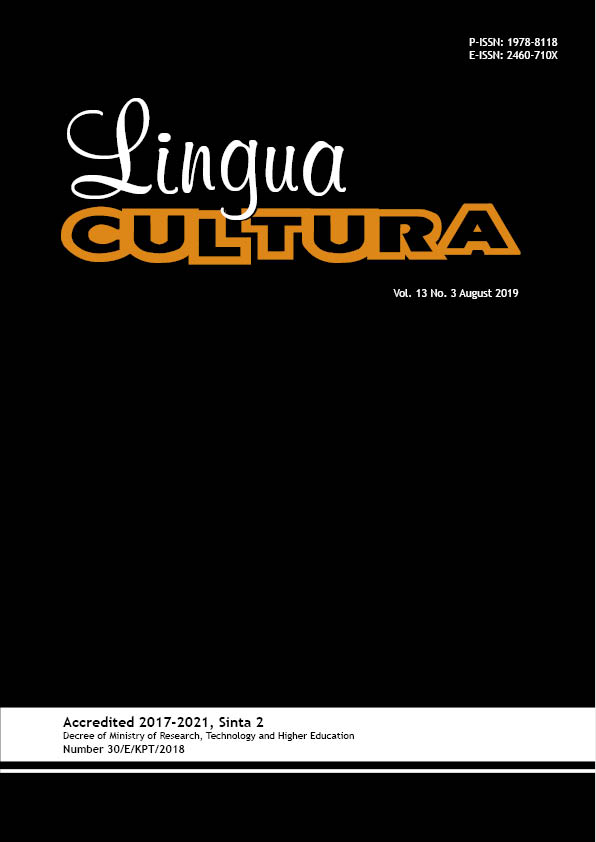Japanese Language Rhetoric of the Japanese Education Students’ at the Speech Contest
DOI:
https://doi.org/10.21512/lc.v13i3.5742Keywords:
Japanese language, Japanese rhetoric, speech contestAbstract
The research aimed to analyze the speech rhetoric quality of the students of Japanese Language Education, Brawijaya University using a descriptive qualitative design. The method applied a discourse analysis method written by Krippendoff which included coding, classification, interpretation, and evaluation. The object of this research was students’ speech for Japanese Speech Contest of UB 2018. The data were seven video recordings of seven speeches delivered by seven students who participated in this speech contest. It it concluded that the quality of the students’ speech is not satisfactory in the criteria of content and expression. The students also show weaknesses in pronunciation and grammar in their speech. This research indicates that when the students are allowed to be honest to express their mind freely in the Japanese language, the speech will reflect each student’s actual language mastery, because language teaching inside the classroom is the most dominant language exposure for the students, any advancement in Japanese language teaching will significantly uplift the quality of
the speech.
References
Almuhimedi, R. A., & Alshumaimeri, Y. A. (2015). Effective error correction in grammar classes: A students’ perspective. American International Journal of Contemporary Research, 5(6), 127-138.
Alqahtani, M. (2015). The importance of vocabulary in language learning and how to be taught. International Journal of Teaching and Education, 3(3), 21–34. https://doi.org/10.20472/TE.2015.3.3.002
Arsyad, M. G., & Mukti, U. S. (2005). Pembinaan kemampuan berbicara bahasa Indonesia. Jakarta: Erlangga.
Bermani, R. A., Safnil, S., & Arono, A. (2019). An analysis of argument structure of research article of English Postgraduate program of Bengkulu University Published In Journal. JOALL (Journal of Applied Linguistics and Literature), 2(2), 47-64. https://doi.org/10.33369/joall.v2i2.5954.
Hendarto, E. (2012). The use of project work to promote students’ motivation toward English class among 10 graders of State Senior High School 1 Purworejo. Yogyakarta: Universitas Negeri Yogyakarta.
Littlejohn, S. W., & Foss., K. A. (2014). Teori komunikasi manusia (9th Ed.). Translated by Mohammad Yusuf Hamdan. Jakarta: Salemba Humanika.
Livia, L., & Suenarto, S. (2015). Retorika Barack Hussein Obama dan Susilo Bambang Yudhoyono dalam menanggapi isu ISIS di dunia. Jurnal Komunikasi, 7(1), 70-80.
Nassaji, H. (2015). Qualitative and descriptive research: Data type and data analysis. Language Teaching Research, 19(2), 129-132. doi: 10.1177/1362168815572747.
Noermanzah, N., Emzir, E., & Lustyantie, N. (2017). Variety of rhetorics in political speech president of the Republic of Indonesia Susilo Bambang Yudhoyono and Joko Widodo in educational field. Humanus: Jurnal Ilmiah Ilmu-Ilmu Humaniora, 16(2), 221-238. https://doi.org/10.24036/humanus.v16i2.8103.
Sugiyono. (2012). Metode penelitian kuantitatif, kualitatif, dan R&D. Bandung: Alfabeta. https://doi.org/10.1017/CBO9781107415324.004.
Syaifudin, A. (2001). Metodologi penelitian. Yogyakarta: Perpustakaan Pelajar.
Syarofi, A., Kuswahono, D., & Rizky, H. (2018). Implementing process writing strategy using weblogs to improve students’ ability in writing descriptive text. Lingua Cultura, 12(4), 351-355. https://doi.
org/10.21512/lc.v12i4.4142.
Taufiqulloh., Yuvita., & Sulistianingsih, E. (2018). Analysis of student attitudes to develop a self-assessment model of genre-based writing class. Lingua Cultura, 12(3), 253-258. https://doi.org/10.21512/lc.v12i3.4064.
Widiantara, I. W. P., Wendra, I. W., & Sriasih, S. A. P. (2014). Kajian retorika dalam naskah pidato pada siswa kelas X.I SMA Negeri 1 Pupuan. E-Jurnal Pendidikan Bahasa Dan Sastra Indonesia, Undiksha, 2(1), 1-10.
Wiyanto, A. (2001). Terampil pidato. Jakarta: Grasindo.
Downloads
Published
How to Cite
Issue
Section
License
Authors who publish with this journal agree to the following terms:
a. Authors retain copyright and grant the journal right of first publication with the work simultaneously licensed under a Creative Commons Attribution License - Share Alike that allows others to share the work with an acknowledgment of the work's authorship and initial publication in this journal.
b. Authors are able to enter into separate, additional contractual arrangements for the non-exclusive distribution of the journal's published version of the work (e.g., post it to an institutional repository or publish it in a book), with an acknowledgment of its initial publication in this journal.
c. Authors are permitted and encouraged to post their work online (e.g., in institutional repositories or on their website) prior to and during the submission process, as it can lead to productive exchanges, as well as earlier and greater citation of published work.
USER RIGHTS
All articles published Open Access will be immediately and permanently free for everyone to read and download. We are continuously working with our author communities to select the best choice of license options, currently being defined for this journal as follows: Creative Commons Attribution-Share Alike (CC BY-SA)


















